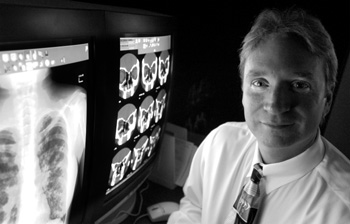
Johnny Hendricks, assistant director of Information Systems for Radiology, supervises the expansion of Vanderbilt’s picture archiving and communication system. (photo by Dana Johnson)
Radiology phasing out film
In a move that allows new efficiency in Vanderbilt patient care, education and research, the radiology department will phase out the use of film by the end of the year, capturing virtually all images in digital format for examination via computer monitors. The transition to digital has been rapid in radiology, which used film exclusively until the 1997 introduction of the Vanderbilt picture archiving and communications system, or PACS.
“Most radiologists here can’t wait for the day when everything is on PACS,” said Dr. Jeremy Kaye, professor and vice chair of Radiology and Radiological Sciences. “The day I never touch another piece of film will be the happiest day of my life.”
While PACS involves physicians viewing images on pricey, high-resolution, centrally located Vanderbilt work stations, radiologists and other doctors also find utility in the Web version of PACS, where images are viewed on typical computer monitors. The Informatics Center, by tapping into the Web version of Vanderbilt PACS, will magnify the benefits of PACS expansion. Informatics will index all PACS images to the StarChart on-line patient record. For StarChart users the linkage will be seamless; the images, along with the image manipulation capabilities of PACS Web, will appear as simply another function within StarChart. (Radiologists’ written reports have been available in StarChart all along.)
Radiology performs approximately 5,000 procedures per week. Studies from off campus imaging facilities (Hillsboro Village, Cool Springs) are already available on StarChart. Later this month, StarChart will include all radiology department MRI, CT and ultrasound images, roughly half of the X-rays generated by the department, and all ultrasounds generated by obstetrics and gynecology. The remaining X-rays will be in Starchart by the end of the year. Mammograms will be incorporated in PACS/StarChart at a later date. Images generated by cardiology may also eventually be added.
By the end of the year all stationary X-ray machines will have converted to digital radiography, bypassing film altogether. One digital radiography machine installed recently in Medical Center East is handling the workload of the former two conventional X-ray units used at that facility. Portable X-ray machines will continue to involve conversion of film to digital format.
“Meeting Vanderbilt’s strategic five-year plan requires systems improvement to support increased throughput in the hospital and clinic,” said Dr. Martin Sandler, professor and chair of Radiology and Radiological Sciences. “Expanded use of digital radiography and PACS will improve efficiency and convenience for patients and clinicians, while also providing potent new tools for teaching and research.”
Doctors will no longer have to chase down and sort through film. “An end to the era of lost films would of itself be significant for this institution,” Kaye said. Surgeons at work in the OR will have instant access to images. With the new digital radiography units, technicians will know instantly whether they’ve captured a diagnostic-quality image; a patient sent to X-ray typically requires multiple images, and it formerly took three to five minutes to develop each image, but patients will now be in and out much quicker. When patients leave Vanderbilt they can take away a CD-ROM rather than sheathes of film, and patients bringing X-rays from outside can have them scanned into the system. Film library staff can move to PACS roles. Doctors who formerly had slides made will find it much easier to incorporate radiological images into their lectures.
The linkage of StarChart to PACS is the work of Dario Giuse, associate professor of Biomedical Informatics and project leader for StarChart/StarPanel.













